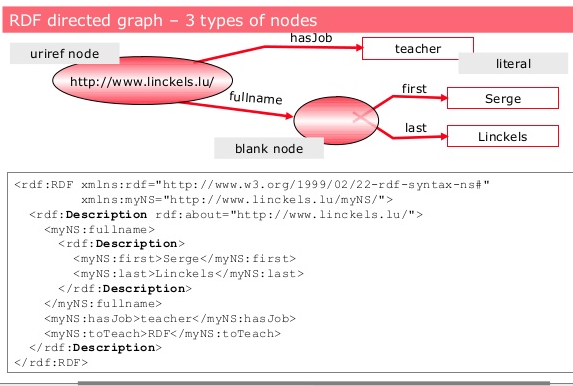RDF:
RDF stands for Resource Description
Framework.
RDF is a standard for describing Web
resources.
RDF can be used to describe title, author,
content, and copyright information of web pages.
At the simplest level, the Resource
Description Framework is an XML-based language to describe resources.
Resource as an electronic file available
via the Web.
Such a resource is accessed via a
Uniform Resource Locator (URL).
RDF captures meta data about the
“externals” of a document, like the author, the creation date, and type.
RDF is not designed
for being displayed to people
RDF is written in XML
RDF is a part of the
W3C's Semantic Web Activity
RDF is a W3C
Recommendation
RDF was
designed to provide a common way to describe information so it can be read and
understood by computer applications.
RDF
descriptions are not designed to be displayed on the web.
A standard model for data interchange on the
Web.
RDF extends the
linking structure of the Web to use URIs to name the relationship between
things as well as the two ends of the link (this is usually referred to as a
“triple”). Using this simple model, it allows structured and semi-structured
data to be mixed, exposed, and shared across different applications.
This linking
structure forms a directed, labelled graph, where the edges represent the named
link between two resources, represented by the graph nodes. This graph view is
the easiest possible mental model for RDF and is often used in
easy-to-understand visual explanations.
Representation:
RDF statements (or triples) can
be encoded in a number of different formats, whether XML based (e.g., RDF/XML)
or not (Turtle, N-triples, …). In general it does not really matter which of
these formats (or serializations) are used to express data—the information is
represented in RDF triples and the particular format is only the “syntactic
sugar”. Most RDF tools can parse several of these serialization formats.
Compare to “numbers” as opposed
to “numerals”. Numbers are mathematical concepts; numerals are a representation
thereof using Roman, Arabic, hexadecimal, octal, etc, representations. Some of
those representations (like Roman) may be very complicated, some of those may
be simpler or more familiar, but they all represent the same abstract concept.
RDF rules:
RDF uses Web identifiers (URIs) to identify
resources.
RDF describes resources with properties and
property values.
RDF Example’s:
01)The Presentation
is given by Pradeep,Ashok,Uday,Mohan
RDF:XML
<?xml version="1.0"?>
<rdf:RDF
xmlns:rdf="http://www.w3.org/1999/02/22-rdf-syntax-ns#"
xmlns:ex="http://www.example.org/">
<rdf:Description
rdf:about="http://www.example.org">
<ex:isgivenby>
<rdf:Bag>
<rdf:li rdf:resource=’ex:Pradeep’/>
<rdf:li rdf:resource=’ex:Ashok’/>
<rdf:li rdf:resource=’ex:Uday’/>
<rdf:li rdf:resource=’ex:Mohan’/>
</rdf:Bag>
</ex:isgivenby>
</rdf:Description>
</rdf:RDF>
N3 Notation:
@prefix
rdf:<"http://www.w3.org/1999/02/rdf-schema">
@prefix rdf:<"http://www.w3.org/1999/02/22-rdf-syntax-ns#">
@prefix ex:<"http://www.example.org/">
ex:Presentation ex:isgivenby _:bnode1
_:bnode1
rdf:type rdf:Bag;
rdf:_1 ex:Ashok;
rdf:_2 ex:Pradeep;
rdf:_3 ex:Mohan;
rdf:_4 ex:Uday;
02)The Protege Software can be downloaded from three links
link1,link2,link3.
<?xml version="1.0"?>
<rdf:RDF
xmlns:rdf="http://www.w3.org/1999/02/22-rdf-syntax-ns#"
xmlns:si="http://www.example.org/">
<rdf:Description rdf:about="http://www.example.org/Protege">
<ex:Sourcelocation>
<rdf:Alt>
<rdf:li rdf:resource=’ http://www.example.org/Protege/link2’
/>
<rdf:li rdf:resource=’ http://www.example.org/Protege/link3’
/>
</rdf:Alt>
</ex:sourcelocation>
</rdf:Description>
</rdf:RDF >
N3:
@prefix
rdf:<"http://www.w3.org/1999/02/22-rdf-syntax-ns#">
@prefix ex:<"http://www.example.org/">
ex:Presentation ex:isgivenby _:bnode1
_:bnode1
rdf:type rdf:Alt;
rdf:_1 ex:link1;
rdf:_1 ex:link2;
rdf:_1 ex:link3;

0 comments:
Post a Comment